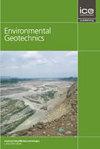Stability Analysis of Earth Dam Slopes Based on the Second-Order Work Criterion in Finite Element Modeling
IF 2.2
4区 工程技术
Q3 ENGINEERING, GEOLOGICAL
引用次数: 0
Abstract
Slope instability issues could cause severe damage and endanger the population, especially when dams are concerned. Over the past years, more and more refined numerical approaches have been proposed to evaluate the slope stability. However, a criterion based on the lack of numerical convergence is generally considered to compute the safety factor with this kind of approaches, which may result in a dramatic increase in the overall computation time for the probabilistic assessment of the safety factor (e.g., using Monte Carlo simulations that require the automation of a large number of simulations). This paper proposes an original approach coupling the shear strength reduction technique with the second-order work criterion. This approach is implemented in the open finite element software Cast3M, version 22.0. The relevance and efficiency of the developed approach is illustrated with two case studies: a heuristic slope and an existing earth dam. Safety factors similar to those calculated by classical approaches are obtained, but without pushing the calculation to the point of non-convergence. Among other advantages described in the paper, the proposed approach makes it possible to compute safety factors using a rational and physically based criterion, while facilitating probabilistic calculations.基于有限元二阶功准则的土坝边坡稳定性分析
边坡失稳问题会造成严重的破坏,危及人口,特别是大坝。近年来,人们提出了越来越多精细化的边坡稳定性评价数值方法。然而,基于缺乏数值收敛性的准则通常被认为用这种方法来计算安全系数,这可能导致安全系数概率评估的总体计算时间急剧增加(例如,使用蒙特卡罗模拟,需要大量模拟的自动化)。提出了一种将抗剪强度折减法与二阶功准则相结合的方法。该方法在开放有限元软件Cast3M 22.0版中实现。用两个实例说明了所开发方法的相关性和有效性:一个启发式边坡和一个现有的土坝。得到了与经典方法相似的安全系数,但没有将计算推到非收敛点。在本文中描述的其他优点中,所提出的方法使得使用合理的和基于物理的标准计算安全系数成为可能,同时促进了概率计算。
本文章由计算机程序翻译,如有差异,请以英文原文为准。
求助全文
约1分钟内获得全文
求助全文
来源期刊

Environmental geotechnics
Environmental Science-Water Science and Technology
CiteScore
6.20
自引率
18.20%
发文量
53
期刊介绍:
In 21st century living, engineers and researchers need to deal with growing problems related to climate change, oil and water storage, handling, storage and disposal of toxic and hazardous wastes, remediation of contaminated sites, sustainable development and energy derived from the ground.
Environmental Geotechnics aims to disseminate knowledge and provides a fresh perspective regarding the basic concepts, theory, techniques and field applicability of innovative testing and analysis methodologies and engineering practices in geoenvironmental engineering.
The journal''s Editor in Chief is a Member of the Committee on Publication Ethics.
All relevant papers are carefully considered, vetted by a distinguished team of international experts and rapidly published. Full research papers, short communications and comprehensive review articles are published under the following broad subject categories:
geochemistry and geohydrology,
soil and rock physics, biological processes in soil, soil-atmosphere interaction,
electrical, electromagnetic and thermal characteristics of porous media,
waste management, utilization of wastes, multiphase science, landslide wasting,
soil and water conservation,
sensor development and applications,
the impact of climatic changes on geoenvironmental, geothermal/ground-source energy, carbon sequestration, oil and gas extraction techniques,
uncertainty, reliability and risk, monitoring and forensic geotechnics.
 求助内容:
求助内容: 应助结果提醒方式:
应助结果提醒方式:


